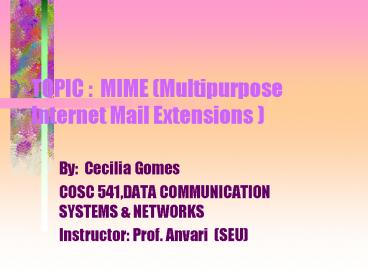TOPIC : MIME (Multipurpose Internet Mail Extensions ) - PowerPoint PPT Presentation
Title:
TOPIC : MIME (Multipurpose Internet Mail Extensions )
Description:
TOPIC : MIME (Multipurpose Internet Mail Extensions ) By: Cecilia Gomes COSC 541,DATA COMMUNICATION SYSTEMS & NETWORKS Instructor: Prof. Anvari (SEU) – PowerPoint PPT presentation
Number of Views:192
Avg rating:3.0/5.0
Title: TOPIC : MIME (Multipurpose Internet Mail Extensions )
1
TOPIC MIME (Multipurpose Internet Mail
Extensions )
- By Cecilia Gomes
- COSC 541,DATA COMMUNICATION SYSTEMS NETWORKS
- Instructor Prof. Anvari (SEU)
2
Multipurpose Internet Mail Extensions ( MIME )
- In 1992, a new standard was defined by an
Internet Engineering Task Force Working Group -
called MIME. - MIME is a specification for enhancing the
capabilities of standard Internet electronic mail.
3
When using the MIME standard, messages can
contain the following types
- Text messages in US-ASCII.
- Character sets other than US-ASCII.
- Multi-media Image, Audio, and Video messages.
- Multiple objects in a single message.
- Multi-font messages.
- Messages of unlimited length.
- Binary files.
4
- MIME is defined to be completely backwards
compatible, yet flexible and open to extensions.
Therefore, it builds on the older standard by
defining additional fields for the mail message
header, that describes new content types, and a
distinct organization of the message body.
5
Background
- SMPT ( Simple Mail Transfer Protocol ) is widely
used around the world, it is the standard
protocol for transferring mail between hosts in
the TCP/IP suite.
6
- However, SMPT has been limited to the delivery of
simple text messages which does not meet the
rising demand for capability of delivery mail
containing various types of data, including
voice, images and video clips. - To satisfy this requirement, a new electronic
mail standard, which builds on SMPT, has been
defined.
7
Limitations of the SMPT scheme
- The message may contain only US-ASCII characters
- The maximum line length allowed is 1000
characters - The message must not be longer than a predefined
maximum size - Cannot transmit executable files or other binary
objects.
8
Limitations of the SMPT scheme .contd
- It cannot transmit text data that includes
national language characters ( 8-bit codes)
because it is limited to 7-bit ASCII. - SMPT servers may reject mail message over a
certain size. - SMPT gateways that translate between ASCII and
the Character code EBCDIC do not use a consistent
set of mappings, resulting in translation
problems.
9
MIME is compatible with existing implementations
- MIME is intended to resolve these problems in a
manner that is compatible with exiting
implementations. - A number of content formats are defined, thus
standardizing representations that support
multimedia electronic mail. - Transfer encodings are defined that enable the
conversion of any content format that is
protected from alteration by the mail system.
10
Technical Specifications
- It explicitly describes the set of allowable
Content-types. - Text - Used to represent textual information.
- Image - this type is for transmitting still
images. - Audio- this content type is for transmitting
audio or voice data.. - Video - The Video content type is for
transmission of video data or moving image data.
11
Technical Specifications . .contd
- MIME encapsulates binary data in ASCII mail
envelope. - Multipart - Used to combine several body parts of
possibly different types subtypes. - Application - Can be used to transmit
application data (such as executables) or binary
data.
12
MIME defines the following new header fields
- MIME-Version - e.g version 1.0
- Content-Transfer-encoding - which specifies how
the data is encoded to allow it to pass through
mail transports having data or character set
limitations. - Many Content-Types that could be transported by
e-mail are represented as 8-bit character or
binary data. Such data cannot be transmitted over
some transport protocols, such as SMTP ( Simple
Mail Transfer Protocol is an Internet standard
for transporting e-mail which restricts mail
messages to 7-bit ASCII data). MIME provides
re-encoding such data into 7-bit short-line
format.
13
Message Fragmentation and Reassembly
- allows large entities to be delivered as several
separate pieces of mail and automatically
reassembled by a receiving user agent.( The
concept is similar to IP fragmentation and
reassembly in the basic Internet Protocols. ) - This makes it possible, for example,to send a
large audio message as several partial messages,
and still have it appear to the recipient as a
simple audio message.
14
MIME - Today Tomorrow
- The MIME standard is written to allow todays
standard to be extended in certain ways, without
having to revise the standard. - Several issues have been left open, and will be
defined when their use becomes clearer
15
- e.g. The working group settled on a relatively
small set of "legal" character sets, and that
several more character sets will inevitably be
added to the base set defined in MIME - Also, it is intended that the MIME mechanism will
move gracefully into an 8-bit world should 8-bit
transport become commonplace in accordance with
the mechanisms drafted by the SMTP extensions
working group.
16
- END































